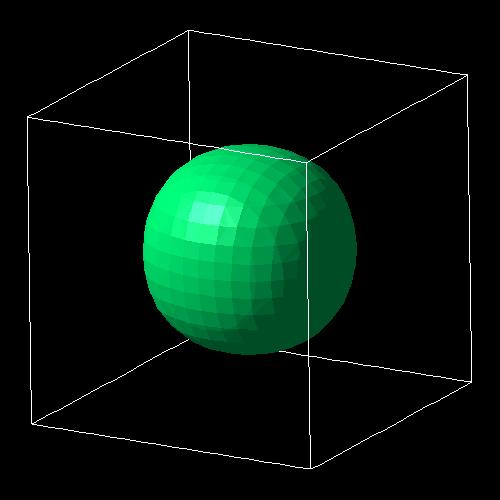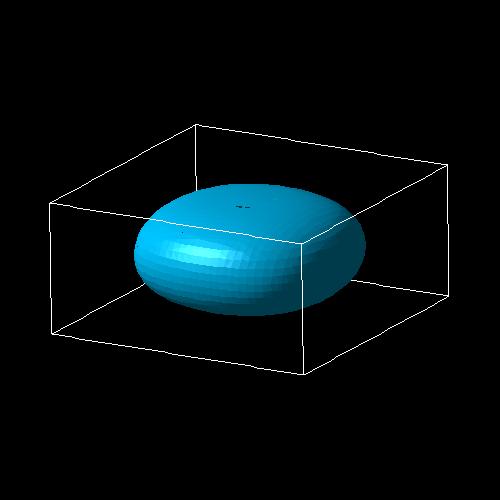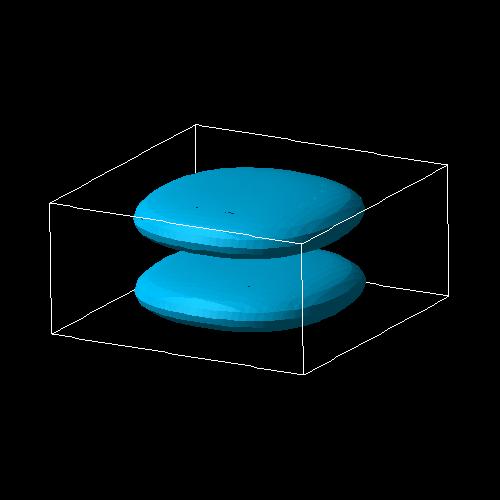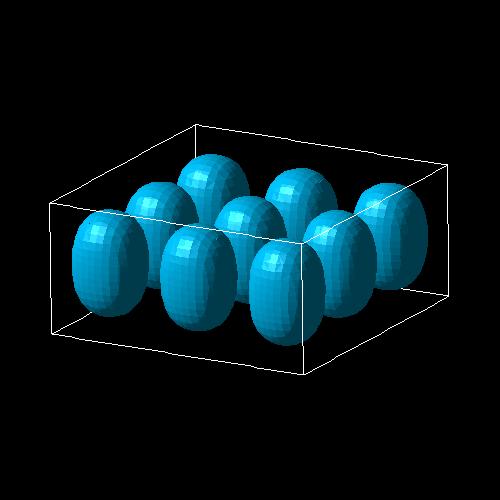Energy levels in idealistic 3D cubic and cuboidal shaped quantum dots¶
- Input files:
3D_wave_functions_cubic_QD_nnp.in
3D_wave_functions_cuboid_QD_nnp.in
3D_wave_functions_cubic_QD_nn3.in
3D_wave_functions_cuboid_QD_nn3.in
- Scope:
The energy levels and the wave functions of a cubic and cuboidal quantum dot
- Output files:
bias_00000\Quantum\energy_spectrum_quantum_region_Gamma.dat
bias_00000\Quantum\probability_quantum_region_Gamma_xxxx.fld
Energy levels in an idealistic 3D cubic quantum dot¶
Input file: 3D_wave_functions_cubic_QD_nnp.in
Here, we want to calculate the energy levels and the wave functions of a cubic quantum dot with lengths \(L_x\) = \(L_y\) = \(L_z\) = 10 nm. We assume that the barriers at the QD boundaries are infinite. This way we can compare our numerical calculations to analytical results. The potential inside the QD is assumed to be 0 eV. As effective mass we take the electron effective mass of \(InAs\), i.e. \(m_e\) = 0.026 \(m_0\).
A discussion of the analytical solution of the 3D Schrödinger equation of a particle in a box (i.e. quantum dot) with infinite barriers can be found in e.g. [MitinKochelapStroscio1999]. The solution of the Schrödinger equation leads to the following eigenvalues:
where
\(E_{n_1, n_2, n_3}\) is the total electron energy,
\(n_1\), \(n_2\) and \(n_3\) are three discrete quantum numbers(because we have three directions of quantization) and
\(L_x,\) \(L_y\) and \(L_z\) are the lengths along the \(x\), \(y\) and \(z\) directions.
In the last line of eq. (2.4.46) we used the fact that \(L_x\) = \(L_y\) = \(L_z\) and factored out 1/(10 nm)2.
Generally, the energy levels are not degenerate, i.e. all energies are different. However, some energy levels with different quantum numbers coincide, if the lengths along two or three directions are identical or if their ratios are integers. In our cubic QD case, all three lengths are identical. Consequently, we expect the following degeneracies:
\(E_{111}\) = 0.43388 eV (ground state)
\(E_{112}\) = \(E_{121}\) = \(E_{211}\) = 0.86776 eV = \(2 E_{111}\)
\(E_{122}\) = \(E_{212}\) = \(E_{221}\) = 1.30164 eV = \(3 E_{111}\)
\(E_{113}\) = \(E_{131}\) = \(E_{311}\) = 1.59090 eV = \(11/3 E_{111}\)
\(E_{222}\) = 1.73552 eV = \(4 E_{111}\)
\(E_{123}\) = \(E_{132}\) = \(E_{213}\) = \(E_{231}\) = \(E_{312}\) = \(E_{321}\) = 2.02478 eV = \(14/3 E_{111}\)
\(E_{333}\) = 3.90493 eV = \(17/3 E_{111}\)
The nextnano++ numerical results for a 10 nm cubic quantum dot with 0.50 nm grid spacing (The grid spacing is rather coarse but has the advantage that the calculation takes only a few seconds.):
num_ev: eigenvalue [eV]:
(0.50 nm grid)
1 0.432989 = E111
2 0.862425 (three-fold degenerate) E112/E121/E211
3 0.862425 (three-fold degenerate) E112/E121/E211
4 0.862425 (three-fold degenerate) E112/E121/E211
5 1.291860 (three-fold degenerate) E122/E212/E221
6 1.291860 (three-fold degenerate) E122/E212/E221
7 1.291860 (three-fold degenerate) E122/E212/E221
8 1.566392 (three-fold degenerate) E113/E131/E311
9 1.566392 (three-fold degenerate) E113/E131/E311
10 1.566392 (three-fold degenerate) E113/E131/E311
11 1.721296 = E222
12 1.995828 (six-fold degenerate) E123/E132/E213/E231/E312/E321
13 1.995828 (six-fold degenerate) E123/E132/E213/E231/E312/E321
14 1.995828 (six-fold degenerate) E123/E132/E213/E231/E312/E321
15 1.995828 (six-fold degenerate) E123/E132/E213/E231/E312/E321
16 1.995828 (six-fold degenerate) E123/E132/E213/E231/E312/E321
17 1.995828 (six-fold degenerate) E123/E132/E213/E231/E312/E321
18 2.425263 (three-fold degenerate) E223/E232/E322
19 2.425263 (three-fold degenerate) E223/E232/E322
20 2.425263 (three-fold degenerate) E223/E232/E322
21 2.527557 (three-fold degenerate) E114/E141/E411
22 2.527557 (three-fold degenerate) E114/E141/E411
23 2.527557 (three-fold degenerate) E114/E141/E411
24 2.699795 (three-fold degenerate) E233/E323/E332
25 2.699795 (three-fold degenerate) E233/E323/E332
26 2.699795 (three-fold degenerate) E233/E323/E332
27 2.956993 (six-fold degenerate) E124/E142/E214/E241/E412/E421
28 2.956993 (six-fold degenerate) E124/E142/E214/E241/E412/E421
29 2.956993 (six-fold degenerate) E124/E142/E214/E241/E412/E421
30 2.956993 (six-fold degenerate) E124/E142/E214/E241/E412/E421
31 2.956993 (six-fold degenerate) E124/E142/E214/E241/E412/E421
32 2.956993 (six-fold degenerate) E124/E142/E214/E241/E412/E421
...
48 3.833198 = E333
...
Figure 2.4.179 and Figure 2.4.180 show the isosurfaces of the electron wave function (\(\Psi^2\)) of the ground state and the 11th state, respectively. Both states are nondegenerate.

Figure 2.4.179 Isosurfaces of the electron wave function (\(\Psi^2\)) of a 10 nm cubic quantum dot with infinite barriers for the ground state \(E_{111}\).¶

Figure 2.4.180 Isosurfaces of the electron wave function (\(\Psi^2\)) of a 10 nm cubic quantum dot with infinite barriers for the 11th eigenstate \(E_{222}\).¶
Intraband (= intersubband) transitions¶
quantum{
region{
...
intraband_matrix_elements{
direction = [0,0,1] # along z direction
Gamma{} # Calculates the matrix element < psi_f* | p_z | psi_i > for electron states at Gamma.
output_oscillator_strengths = yes # Output oscillator strength f_fi
}
}
}
In this cubic QD with infinite barriers, optical intraband transitions are only allowed between states with odd difference quantum numbers along the same axes:
\(E_{111} \Leftrightarrow{} E_{112}/ \; E_{121}/ \; E_{211}\)
1 \(\Leftrightarrow{}\) 2 / 3 / 4
\(E_{111} \Leftrightarrow{} E_{114}/ \; E_{141}/ \; E_{411}\)
1 \(\Leftrightarrow{}\) 21 / 22 / 23
\(E_{211} \Leftrightarrow{} E_{311}\)
2 \(\Leftrightarrow{}\) 8
\(E_{121} \Leftrightarrow{} E_{131}\)
3 \(\Leftrightarrow{}\) 9
\(E_{112} \Leftrightarrow{} E_{113}\)
4 \(\Leftrightarrow{}\) 10
The following transitions are forbidden:
\(E_{111} \Leftrightarrow{} E_{113}/ \; E_{131}/ \; E_{311}\)
1 \(\Leftrightarrow{}\) 8 / 9 / 10
\(E_{211} \Leftrightarrow{} E_{112}/ \; E_{121}\)
2 \(\Leftrightarrow{}\) 3 / 4
\(E_{121} \Leftrightarrow{} E_{211}/ \; E_{112}\)
3 \(\Leftrightarrow{}\) 2 / 4
\(E_{112} \Leftrightarrow{} E_{211}/ \; E_{121}\)
4 \(\Leftrightarrow{}\) 2 / 4
Energy levels in an idealistic 3D cuboidal shaped quantum dot with \(L_x = L_y \neq L_z\)¶
Input file: 3D_wave_functions_cuboid_QD_nnp.in
This time we use a similar quantum dot as above, but the lengths are now \(L_x\) = \(L_y\) = 10 nm and \(L_z\) = 5 nm. Therefore, the degeneracies of the eigenenergies are different. We expect the following:
Generally, the energy levels are not degenerate, i.e. all energies are different. However, some energy levels with different quantum numbers coincide, if the lengths along two or three directions are identical or if their ratios are integers. In our cubic QD case, all three lengths are identical. Consequently, we expect the following degeneracies:
\(E_{111}\) = 0.86776 eV (ground state)
\(E_{121}\) = \(E_{211}\) = 1.301642 eV
\(E_{221}\) = 1.73552 eV = \(2 E_{111}\) (This is a coincidence because \(L_{x,y}\) / \(L_z\) are integers and have the value 2.)
\(E_{131}\) = \(E_{311}\) = 2.02478 eV
\(E_{231}\) = \(E_{321}\) = 2.45866 eV
\(E_{112}\) = 2.60329 eV = \(2 E_{121}\) (This is a coincidence because \(L_{x,y}\) / \(L_z\) are integers and have the value 2.)
\(E_{122}\) = \(E_{212}\) = \(E_{141}\) = \(E_{411}\) = 3.03717 eV (This is a coincidence because \(L_{x,y}\) / \(L_z\) are integers and have the value 2.)
\(E_{331}\) = 3.18180 eV
\(E_{222}\) = \(2 E_{221}\) = \(E_{241}\) = \(E_{421}\) = 3.47105 eV (This is a coincidence because \(L_{x,y}\) / \(L_z\) are integers and have the value 2.)
\(E_{132}\) = \(E_{312}\) = 3.76030 eV
\(E_{341}\) = \(E_{431}\) = \(E_{232}\) = \(E_{322}\) = 4.19418 eV (This is a coincidence because \(L_{x,y}\) / \(L_z\) are integers and have the value 2.)
\(E_{151}\) = \(E_{511}\) = 4.33881 eV
\(E_{142}\) = \(E_{412}\) = \(E_{251}\) = \(E_{521}\) = 4.77269 eV (This is a coincidence because \(L_{x,y}\) / \(L_z\) are integers and have the value 2.)
\(E_{332}\) = 4.91731 eV
\(E_{441}\) = \(E_{242}\) = \(E_{422}\) = 5.20657 eV (This is a coincidence because \(L_{x,y}\) / \(L_z\) are integers and have the value 2.)
\(E_{113}\) = 5.49582 eV
\(E_{123}\) = 5.92971 eV
The nextnano++ numerical results for a 10 nm cubic quantum dot with 0.50 nm grid spacing (left column) and 0.25 nm grid spacing (right column). (The grid spacing is rather coarse (for 0.50 nm) but has the advantage that the calculation takes only a few seconds.)
num_ev: eigenvalue [eV]:
(0.50 nm grid) (0.25 nm grid)
1 0.862425 0.866424 = E111
2 1.291860 1.299191 (two-fold degenerate) = E121/E211
3 1.291860 1.299191 (two-fold degenerate) = E121/E211
4 1.721296 1.731958 = E221
5 1.995828 2.017504 (two-fold degenerate) = E131/E311
6 1.995828 2.017504 (two-fold degenerate) = E131/E311
7 2.425263 2.450270 (two-fold degenerate) = E231/E321
8 2.425263 2.450270 (two-fold degenerate) = E231/E321
9 2.527557 2.584167 = E112
10 2.956993 3.016933 (four-fold degenerate) = E122/E212/E141/E411
11 2.956993 3.016933 (four-fold degenerate) = E122/E212/E141/E411
12 2.956993 3.016933 (four-fold degenerate) = E122/E212/E141/E411
13 2.956993 3.016933 (four-fold degenerate) = E122/E212/E141/E411
14 3.129231 3.168583 = E331
15 3.386428 3.449700 (three-fold degenerate) = E222/E241/E421
16 3.386428 3.449700 (three-fold degenerate) = E222/E241/E421
17 3.386428 3.449700 (three-fold degenerate) = E222/E241/E421
18 3.660960 3.735246 (two-fold degenerate) = E132/E312
19 3.660960 3.735246 (two-fold degenerate) = E132/E312
20 4.090396 4.168013 (four-fold degenerate) = E341/E431/E232/E322
21 4.090396 4.168013 (four-fold degenerate) = E341/E431/E232/E322
22 4.090396 4.168013 (four-fold degenerate) = E341/E431/E232/E322
23 4.090396 4.168013 (four-fold degenerate) = E341/E431/E232/E322
24 4.151688 4.291319 (two-fold degenerate) = E151/E511
25 4.151688 4.291319 (two-fold degenerate) = E151/E511
26 4.581124 4.724086 (four-fold degenerate in theory) = E142/E412/E251/E521
27 4.581124 4.724086 (four-fold degenerate in theory) = E142/E412/E251/E521
28 4.622125 4.734676 (four-fold degenerate in theory) = E142/E412/E251/E521
29 4.622125 4.734676 (four-fold degenerate in theory) = E142/E412/E251/E521
30 4.794363 4.886326 = E332
...
34 5.121061 5.400036 = E441
The following figures: Figure 2.4.181, Figure 2.4.182, Figure 2.4.183 and Figure 2.4.184 show the isosurfaces of the electron wave function (\(\psi^2\)) of the 1st, 4th, 9th and 14th, respectively. All these states are nondegenerate.

Figure 2.4.181 Isosurfaces of the electron wave function (\(\Psi^2\)) of a 10 nm by 10 nm by 5 nm cuboidal shaped quantum dot with infinite barriers for the ground state \(E_{111}\).¶

Figure 2.4.182 Isosurfaces of the electron wave function (\(\Psi^2\)) of a 10 nm by 10 nm by 5 nm cuboidal shaped quantum dot with infinite barriers for the 4th state \(E_{221}\).¶

Figure 2.4.183 Isosurfaces of the electron wave function (\(\Psi^2\)) of a 10 nm by 10 nm by 5 nm cuboidal shaped quantum dot with infinite barriers for the 9th state \(E_{112}\).¶

Figure 2.4.184 Isosurfaces of the electron wave function (\(\Psi^2\)) of a 10 nm by 10 nm by 5 nm cuboidal shaped quantum dot with infinite barriers for the 14th state \(E_{331}\).¶
Last update: nn/nn/nnnn